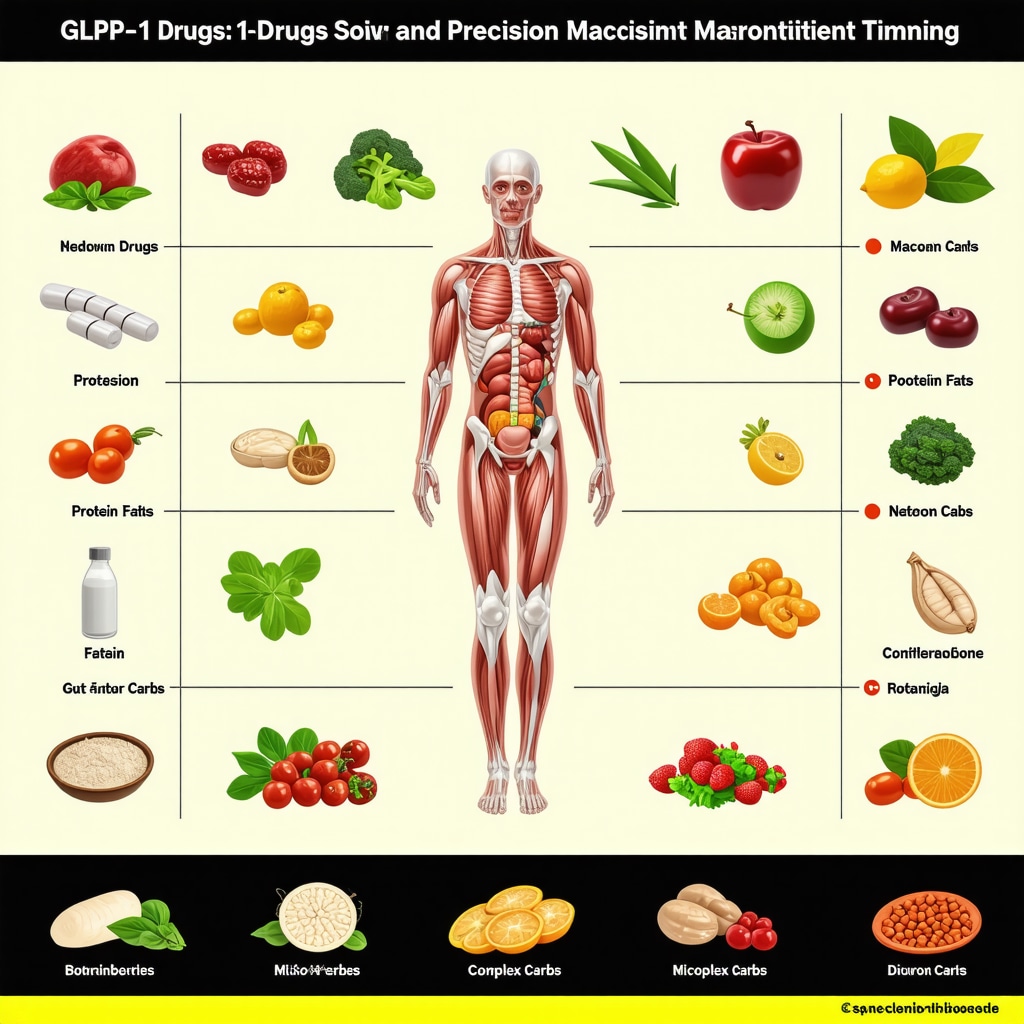Why Your Plate Matters More Than You Think When Using GLP-1 Drugs
Ah, the modern marvels of weight loss: GLP-1 drugs like semaglutide have stormed the scene, offering hope to many who’ve wrestled with stubborn fat. But here’s the kicker — popping a prescription without tuning into your diet is like trying to tune a grand piano with a hammer. It just doesn’t harmonize well. So what foods should you be inviting to this weight-loss party?
Eating Smart: The Secret Sauce to Consistent Fat Loss
First off, GLP-1 drugs work by enhancing insulin secretion and suppressing appetite. This means you’re naturally less hungry, but that doesn’t give a green light to junk food binges. Instead, think nutrient-dense, fiber-rich foods that amplify fat burning and keep you full longer. Imagine lean proteins, vibrant vegetables, and whole grains playing a symphony on your metabolism.
Could the Right Foods Make Your GLP-1 Journey Smoother?
Absolutely. Incorporate foods like fatty fish (hello, omega-3s!), leafy greens loaded with antioxidants, and complex carbs such as quinoa or sweet potatoes. Not only do these foods support the drug’s action, but they also stabilize blood sugar, preventing those pesky energy crashes that derail motivation.
On the flip side, steer clear of heavily processed snacks and sugary drinks. They might sneak under the radar when appetite is suppressed, but they’ll sabotage your progress faster than you can say “metabolic meltdown.”
Fiber: Your Unsung Hero in Fat Loss
Fiber-rich foods aren’t just about digestion — they’re the cornerstone of lasting weight loss. They slow gastric emptying, which gels perfectly with GLP-1’s appetite-suppressing effects. Think berries, legumes, and nuts. Bonus: they feed your gut microbiome, which emerging research links to better weight management (source).
Wondering How to Make This Practical Day-to-Day?
Meal prepping with these ingredients can be your secret weapon. For tailored advice, check out this insightful guide on combining semaglutide with custom diet plans that truly unlock consistent fat loss. And hey, don’t be shy — share your own favorite fat-burning foods or struggles in the comments. After all, we’re in this weight loss journey together.
Synergizing Nutrition and GLP-1 Therapy: Beyond Basics
While many understand that GLP-1 drugs suppress appetite and improve insulin response, the interplay between diet composition and drug efficacy often remains underappreciated. Recent data underscore that not all calories or macros are created equal when paired with these medications. Optimizing macronutrient ratios and micronutrient intake can fine-tune metabolic pathways to elevate fat loss results and minimize side effects such as nausea or fatigue.
How Does Macronutrient Timing Influence GLP-1 Medication Outcomes?
Emerging evidence suggests that synchronizing protein and fiber intake earlier in the day can potentiate the appetite-suppressing effects of GLP-1 analogs, thereby reducing overall caloric intake without sacrificing energy or lean mass. Conversely, excessive simple carbohydrates late in the day may blunt the drug’s benefits by promoting insulin spikes and subsequent fat storage. Integrating complex carbohydrates with low glycemic index and pairing them with healthy fats and proteins throughout the day balances glucose levels and sustains satiety.
For practical meal planning strategies, explore in-depth resources on doctor-recommended diet plans for weight loss medications, which provide customizable templates that align with GLP-1 treatment protocols.
Micronutrients That Matter: Fortifying Your Metabolic Foundation
Micronutrient adequacy is often overlooked in weight loss regimens but is critical when using medications like semaglutide or tirzepatide. Nutrients such as magnesium, vitamin D, and B-complex vitamins support glucose metabolism, energy production, and muscle function, all indispensable for sustained fat loss and workout recovery.
Additionally, antioxidants found in colorful fruits and vegetables combat oxidative stress induced by metabolic shifts during weight loss, supporting cellular health and reducing inflammation. Integrating a diverse spectrum of micronutrients bolsters not only fat loss efforts but overall metabolic resilience.
Leveraging Gut Health: A Crucial Ally for GLP-1 Users
GLP-1 receptor agonists modulate gut motility and hormone release, making gut health a pivotal factor in treatment success. Prebiotic fibers and fermented foods nurture beneficial gut bacteria, which in turn influence energy extraction, appetite regulation, and systemic inflammation.
Emerging research from the National Institutes of Health emphasizes the gut microbiome’s role in weight regulation, suggesting that tailored dietary interventions enhancing gut flora diversity can amplify GLP-1 drug outcomes.
Adapting Meal Prep for Consistency and Compliance
Meal prepping remains a cornerstone for adherence, especially when appetite fluctuates due to medication effects. Structuring meals with balanced macronutrients and incorporating fiber-rich and micronutrient-dense foods ensures both satiety and nutrient adequacy. For detailed guidance, the article on combining fat loss medication with meal prep for success offers expert tips to streamline this process.
Ready to Transform Your Weight Loss Journey? Share Your Insights!
Have you experimented with nutrient timing or gut-friendly diets alongside GLP-1 therapy? Your experiences could illuminate new paths for others navigating similar journeys. Drop a comment below or share this article with your community to foster informed, empowered weight loss strategies.
Optimizing Macronutrient Synergy: Precision Nutrition for GLP-1 Users
Beyond simple calorie counting, the nuanced interplay between macronutrients profoundly influences the pharmacodynamics of GLP-1 receptor agonists. Precision nutrition — tailoring protein, fat, and carbohydrate ratios to individual metabolic phenotypes — can enhance drug efficacy and mitigate common side effects such as gastrointestinal discomfort.
Recent clinical investigations highlight that a higher protein intake, approximately 25-30% of daily calories, supports lean body mass preservation during rapid weight loss phases induced by GLP-1 drugs. When combined with moderate healthy fats, especially monounsaturated and omega-3 fatty acids, this macronutrient profile promotes optimal satiety signaling and anti-inflammatory benefits.
Meanwhile, timing complex carbohydrate consumption around physical activity windows can improve glucose disposal and sustain energy. This temporal macronutrient distribution aligns with circadian rhythms and insulin sensitivity, capitalizing on natural metabolic fluctuations to reduce fat accumulation risks.
What Are the Best Macronutrient Ratios to Complement Semaglutide Therapy for Long-Term Weight Management?
Experts recommend a balanced approach: 30% protein, 30-35% fats (favoring unsaturated fats), and 35-40% low glycemic index carbohydrates. This composition supports sustained energy, minimizes hunger pangs, and aligns with the metabolic effects of GLP-1 receptor agonists. Adjustments should be personalized based on activity level, baseline metabolic health, and gastrointestinal tolerance.
For more detailed macronutrient tuning and meal timing strategies, the National Institutes of Health offers insightful reviews on nutrient-drug interactions affecting weight loss outcomes.
Micronutrient Optimization: The Underestimated Lever in GLP-1-Assisted Weight Loss
While macronutrients steal the spotlight, micronutrients quietly govern metabolic efficiency and tissue repair. Deficiencies in magnesium, vitamin D, and B vitamins can blunt the metabolic improvements GLP-1 drugs aim to achieve. For instance, magnesium acts as a cofactor in over 300 enzymatic reactions, including those regulating glucose metabolism and insulin sensitivity.
Vitamin D’s role extends beyond bone health — it modulates inflammatory pathways and adipocyte function, critical when the body undergoes rapid adipose tissue remodeling. Meanwhile, B-complex vitamins facilitate mitochondrial energy production, helping to maintain stamina during increased physical activity encouraged by weight loss.
Incorporating a varied diet rich in leafy greens, nuts, seeds, and fortified foods, or considering targeted supplementation under medical guidance, ensures these micronutrients support your weight loss journey synergistically with GLP-1 therapy.
Gut Microbiome Modulation: Unlocking the Hidden Potential of GLP-1 Drugs
Emerging research reveals that the gut microbiome’s composition can directly influence GLP-1 receptor agonist effectiveness. Specific bacterial strains metabolize dietary fibers into short-chain fatty acids (SCFAs), which enhance gut barrier integrity, regulate inflammation, and modulate enteroendocrine signaling pathways involved in appetite and glucose regulation.
Dietary strategies that nurture microbial diversity — prebiotic-rich foods like inulin, resistant starches, and fermented products such as kimchi or kefir — can potentiate GLP-1 drug action. Such synergy may translate into improved satiety, reduced insulin resistance, and better overall metabolic control.
Recent findings from the NIH underscore the potential of personalized microbiome-targeted diets to augment pharmacotherapy for obesity and diabetes.

Practical Applications: Integrating Advanced Nutritional Insights into Daily Meal Planning
Implementing these complex nutritional principles requires thoughtful meal planning and lifestyle adjustments. Start by mapping your current diet against macronutrient targets and micronutrient adequacy. Utilize food diaries and nutrient tracking apps to identify gaps and opportunities.
Meal prepping with a focus on high-protein breakfasts rich in fiber, balanced lunches with complex carbs timed around activity, and nutrient-dense dinners can create a metabolic environment that harmonizes with GLP-1 pharmacology. Incorporating gut-friendly snacks like fermented vegetables or nut-based bars further supports microbial health.
Collaborative care involving dietitians, endocrinologists, and behavioral therapists can tailor interventions, manage side effects, and optimize adherence, ultimately translating scientific insights into sustainable weight management success.
Ready to Elevate Your GLP-1 Weight Loss Strategy? Dive Deeper with Expert Guidance
If you’re serious about maximizing your fat loss journey with GLP-1 drugs, consider consulting with healthcare professionals who specialize in metabolic and nutritional therapy. Their expertise can help personalize your macronutrient ratios, micronutrient intake, and meal timing to your unique physiology and lifestyle.
Share your experiences or questions below — your input enriches this ongoing conversation and supports our community’s collective success.
Precision Nutrition Meets GLP-1 Therapy: Unlocking Metabolic Mastery
As GLP-1 receptor agonists continue to revolutionize obesity treatment, the next frontier lies in tailoring advanced nutritional strategies that amplify these medications’ metabolic effects. Beyond basic macros, the intricate dance between nutrient quality, timing, and gut health orchestrates a powerful synergy that can elevate fat loss outcomes while minimizing adverse effects.
How Can Personalized Nutrient Timing Enhance GLP-1 Medication Benefits?
Emerging evidence highlights that nutrient timing — particularly strategic protein and fiber intake earlier in the day — optimizes GLP-1-induced satiety and insulin regulation. Consuming high-quality proteins and soluble fibers at breakfast and lunch not only prolongs fullness but also supports lean muscle mass preservation during rapid weight loss phases. Conversely, limiting simple carbohydrates in the evening helps blunt postprandial insulin spikes that can counteract fat-burning pathways.
This nuanced approach aligns with circadian metabolism, leveraging natural fluctuations in insulin sensitivity to enhance medication efficacy. For a deep dive into expert-approved meal timing and macronutrient distribution tailored for GLP-1 users, visit doctor-recommended diet plans for weight loss medications.
Micronutrient Synergy: The Hidden Catalyst in GLP-1-Assisted Fat Loss
Often overlooked, micronutrient adequacy is fundamental for metabolic optimization during GLP-1 therapy. Magnesium, vitamin D, and B-complex vitamins play pivotal roles in glucose homeostasis, mitochondrial energy production, and inflammation modulation — all critical when the body undergoes rapid adipose tissue remodeling. Deficiencies can blunt medication effects and contribute to fatigue or gastrointestinal discomfort.
Incorporating nutrient-dense foods like leafy greens, nuts, seeds, and fortified products is essential. Supplementation, under medical guidance, may be necessary to address individual gaps. For specialized guidance on micronutrient support alongside GLP-1 drugs, explore GLP-1 drug dietary support: essential nutrients to boost fat burn.
Gut Microbiome Optimization: The Next-Level Ally for GLP-1 Users
The gut microbiota profoundly influences GLP-1 drug performance by modulating enteroendocrine signaling and systemic inflammation. Prebiotic fibers (e.g., inulin, resistant starch) and fermented foods (kimchi, kefir) nurture beneficial bacterial strains that produce short-chain fatty acids (SCFAs), enhancing gut barrier function and appetite regulation.
Recent research published by the National Institutes of Health underscores how tailored microbiome-targeted nutrition can amplify pharmacotherapy outcomes for obesity and diabetes. Integrating these dietary elements can thus potentiate GLP-1 drug benefits and improve long-term metabolic health.

Implementing Advanced Nutritional Synergies: Practical Meal Planning for GLP-1 Therapy
Translating these expert insights into daily habits involves structured meal prep emphasizing macronutrient precision, micronutrient richness, and gut-friendly foods. Start your day with a protein- and fiber-packed breakfast, followed by balanced lunches featuring low glycemic carbohydrates timed around exercise. Incorporate fermented snacks or prebiotic-rich sides to support microbiome diversity.
Collaborative care with dietitians and healthcare providers ensures personalization and manages common side effects, maximizing adherence and fat loss success. For comprehensive tips, check out our article on combining fat loss medication with meal prep for success.
What Are Your Experiences with Advanced Nutrition and GLP-1 Medication?
Have you experimented with nutrient timing, micronutrient supplementation, or gut-friendly diets while on GLP-1 therapy? Share your insights and questions in the comments — your contributions help build a smarter, more supportive community. For ongoing expert advice and personalized plans, visit our resource on combining semaglutide with custom diet plans.
Expert Insights & Advanced Considerations
The Critical Role of Macronutrient Timing in Enhancing GLP-1 Therapy
Optimizing when you consume proteins and fibers — particularly earlier in the day — can significantly potentiate the appetite-suppressing and insulin-regulating effects of GLP-1 receptor agonists. This precision timing not only sustains fullness but also helps preserve lean muscle during rapid fat loss phases, aligning your meals with circadian metabolic rhythms for superior outcomes.
Micronutrient Adequacy as a Metabolic Catalyst
Magnesium, vitamin D, and B-complex vitamins play indispensable roles in glucose metabolism, mitochondrial function, and inflammation control. Ensuring sufficient intake of these micronutrients supports the pharmacodynamics of GLP-1 drugs and helps minimize common side effects such as fatigue and gastrointestinal discomfort, making them a vital yet often underappreciated factor in weight loss success.
Gut Microbiome Modulation: The Underlying Synergistic Partner
Emerging evidence establishes that nurturing a diverse, balanced gut microbiota through prebiotic fibers and fermented foods can amplify GLP-1 drug efficacy. The production of short-chain fatty acids by beneficial bacteria enhances gut barrier integrity and appetite regulation, dovetailing with pharmacotherapy to improve metabolic control and weight management.
Precision Nutrition Tailored to Individual Metabolic Phenotypes
Recognizing that one-size-fits-all macronutrient ratios fall short, tailoring dietary composition to individual metabolic and gastrointestinal profiles maximizes GLP-1 drug benefits. A balanced distribution of approximately 30% protein, 30-35% unsaturated fats, and 35-40% low glycemic carbohydrates, with timing adjustments around activity, supports sustained energy, satiety, and lean mass preservation.
Curated Expert Resources
- National Institutes of Health (NIH) PMC Articles: Comprehensive research reviews detailing nutrient-drug interactions and the gut microbiome’s role in obesity and diabetes management, offering evidence-based insights for advanced nutritional strategies (source).
- Doctor Recommended Diet Plans for Weight Loss Medications: Tailored meal planning templates designed to synergize with GLP-1 receptor agonists, focusing on macronutrient balance and timing to optimize pharmacological outcomes (read more).
- GLP-1 Drug Dietary Support: Essential Nutrients to Boost Fat Burn: A deep dive into micronutrient optimization strategies that complement GLP-1 therapies, improving metabolic efficiency and minimizing side effects (explore here).
- Combining Semaglutide with Custom Diet Plans: Expert Tips: Insightful guidance on integrating personalized nutrition with semaglutide treatment to unlock consistent and sustainable fat loss (discover strategies).
- Combining Fat Loss Medication with Meal Prep for Success: Practical advice on meal prepping to maintain adherence and nutrient adequacy during GLP-1 therapy, streamlining your weight loss journey (learn more).
Final Expert Perspective
Integrating advanced nutritional strategies with GLP-1 drug therapy transcends basic calorie counting to embrace precision nutrition that harmonizes macronutrient timing, micronutrient sufficiency, and gut microbiome health. This multifaceted approach not only magnifies the metabolic impact of GLP-1 medications but also fosters sustainable, safe fat loss with reduced side effects. As the science continues to evolve, personalized dietary frameworks tailored to individual physiology will remain paramount in unlocking the full potential of GLP-1 therapies.
Whether you’re a healthcare professional or an empowered patient, deepening your understanding of these nuanced interactions will enhance outcomes and quality of life. Engage with these resources, share your insights, or consult experts to refine your approach further. For comprehensive expert guidance on combining semaglutide with custom diet plans and advancing your weight loss strategy, visit this resource to elevate your journey with confidence and expertise.


I completely agree with the emphasis on micronutrients like magnesium, vitamin D, and B-vitamins for optimizing fat loss, especially when on GLP-1 meds. Since starting my journey, I’ve noticed that incorporating more leafy greens, nuts, and seeds has made a noticeable difference—not only in my energy levels but also in how I tolerate the medication. Gut health seems to play a bigger role than I initially realized; I’ve added fermented foods like kefir and kimchi, and I feel my digestion and satiety are much better. It’s fascinating how these small dietary tweaks can amplify the effects of the medication. Has anyone else experienced a shift in appetite or digestion after focusing on gut-boosting foods? I’d love to hear more about how different micronutrient strategies have helped others maximize their results while on GLP-1 therapies. It really makes me wonder if personalized micronutrient plans could be the key to pushing fat loss further and reducing side effects.